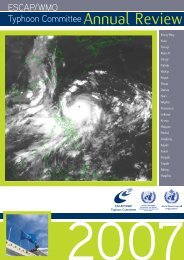TCAR - Typhoon Committee
TCAR - Typhoon Committee
TCAR - Typhoon Committee
Create successful ePaper yourself
Turn your PDF publications into a flip-book with our unique Google optimized e-Paper software.
2.1 REPORT ON INDIVIDUAL<br />
TROPICAL CYCLONES WHICH<br />
AFFECTEDMEMBERS OF THE<br />
TYPHOON COMMITTEE<br />
2.1 Overview<br />
This is a summary of the tropical cyclones that<br />
developed over the western North Pacific and the<br />
adjacent seas bounded by the Equator, 45 o N, 100 o E<br />
and 180 o E. In 2009, a total number of 22 tropical<br />
cyclones (TCs) with tropical storm (TS) intensity or<br />
higher formed in the western North Pacific and the<br />
South China Sea, of which 13 reached typhoon (TY)<br />
intensity, 3 at severe tropical storm (STS) intensity<br />
and 6 at tropical storm (TS) intensity. The total number<br />
of tropical cyclones with tropical storm intensity or<br />
higher is less than the 30 year average (1971 – 2000)<br />
of 26.7.<br />
There were no tropical cyclones developed over the<br />
western North Pacific and South China Sea from<br />
January to April. The first tropical cyclone for the year<br />
2009 occurred in May with the formation of Kujira.<br />
The most intense cyclone was Nida (0922) which had<br />
an estimated wind of 213 km/h and a minimum sealevel<br />
pressure of about 905 hPa when it was located<br />
over the western North Pacific about 370 km west of<br />
Guam. <strong>Typhoon</strong> Lupit (0920) was the tropical cyclone<br />
with the longest life span in 2009 which lasted for<br />
16.5 days.<br />
In 2009, nine tropical cyclones made landfall over<br />
coastal area of China, two crossed Taiwan, five<br />
affected Japan, twelve affected the Philippines and<br />
five made landfall over Vietnam.<br />
KUJIRA (0901) formed as a tropical depression<br />
off the south-eastern coast of Luzon on 1 May and<br />
moved generally northeastwards. It intensified into a<br />
tropical storm and then further intensified into a sever<br />
tropical storm on 3 May. Keeping its northeastwards<br />
track, it was upgraded into a typhoon the next day. It<br />
weakened into a severe tropical storm on 7 May and<br />
then a tropical storm on that afternoon. Kujira became<br />
an extra-tropical cyclone to the east of Japan later.<br />
CHAN-HOM (0902) formed as a tropical depression<br />
over the central part of South China Sea on 2 May<br />
and moved slowly northeastwards and intensified<br />
<strong>TCAR</strong><br />
CHAPTER 2 - TROPICAL CYCLONES 2008<br />
TROPICAL CYCLONES IN 2009<br />
into a tropical storm on 3 May. Moving slowly<br />
northwards, Chan-hom further intensified into a<br />
severe tropical storm the next day. It turned to move<br />
east-northeastwards on 6 May and was upgraded<br />
into a typhoon. Chan-hom crossed Luzon Island soon<br />
after being downgraded into a sever tropical storm.<br />
It weakened into a tropical storm and further into a<br />
tropical depression over the sea east of the Philippines<br />
on 9 May, then turned to move to the north. Keeping<br />
its northerly track, it dissipated south of Okinawa on<br />
13 May.<br />
LINFA (0903) formed as a tropical depression over<br />
the northern part of South China Sea on 17 June and<br />
moved slowly. It intensified into a tropical storm the<br />
next day. Moving northwards, Linfa intensified into<br />
a severe tropical storm over the same waters on 19<br />
June. While moving northeastwards along the coast<br />
of southern China, it was weakening into a tropical<br />
depression on 22 June. It further weakened into an<br />
extra-tropical cyclone over the East China Sea on 23<br />
June.<br />
NANGKA(0904) formed as a tropical depression over<br />
the sea east of the Philippines on 22 June. Moving<br />
west-northwestwards, it intensified into a tropical<br />
storm the next day. Nangka crossed the central<br />
Philippines and entered the South China on 24 June.<br />
Continuing its north-northwesterly trajectory, Nangka<br />
made landfall over the coastal area east of Hong Kong<br />
and weakened into a tropical depression on 26 June<br />
and then dissipated later over southern China.<br />
SOUDELOR (0905) formed as a tropical depression<br />
off the northern coast of Luzon on 9 July and moved<br />
west-northwestwards across the northern part of<br />
South China Sea. It intensified into a tropical storm<br />
on 11 July. Continuing to move west-northwestwards,<br />
Soudelor crossed the northern tip of Leizhou<br />
Peninsula and weakened into a tropical depression on<br />
12 July. It made landfall over the coast of northern<br />
Viet Nam and then dissipated the next day.<br />
MOLAVE (0906) formed as a tropical depression<br />
over the sea east of the Philippines on 15 July and<br />
moved generally northwestwards. It intensified into<br />
a tropical storm the next day. While crossing the<br />
Luzon Strait on 17 July, it further intensified into a<br />
severe tropical storm and then a typhoon. Keeping<br />
its west-northwestwards track, it made landfall<br />
over Shenzhen in the late hour on 18 July. Molave<br />
2009<br />
157

















